Themed collection Journal of Materials Chemistry A Lunar New Year collection 2021

Ferrites: emerging light absorbers for solar water splitting
Ferrites are promising photoelectrode materials for solar water splitting to produce clean and storable hydrogen energy.

J. Mater. Chem. A, 2020,8, 9447-9482
https://doi.org/10.1039/D0TA01554G
Engineering pristine 2D metal–organic framework nanosheets for electrocatalysis
This review highlights recent advances and future opportunities in pristine MOF nanosheets for electrocatalysis.

J. Mater. Chem. A, 2020,8, 8143-8170
https://doi.org/10.1039/D0TA03138K
Two-dimensional transition metal carbide and nitride (MXene) derived quantum dots (QDs): synthesis, properties, applications and prospects
Recent progress of MXene QDs, including their synthesis, properties, applications, and their future perspectives and challenges.

J. Mater. Chem. A, 2020,8, 7508-7535
https://doi.org/10.1039/D0TA01552K
Emerging applications of porous organic polymers in visible-light photocatalysis
Porous organic polymers are efficient photocatalysts in organic synthesis, hydrogen evolution, CO2 reduction, and degradation of organic pollutants.

J. Mater. Chem. A, 2020,8, 7003-7034
https://doi.org/10.1039/D0TA00364F
Covalent organic frameworks: emerging high-performance platforms for efficient photocatalytic applications
In this review, a comprehensive summary of the potential photocatalytic applications realized to date in the fast-growing field of COFs is provided with the aim to present a full blueprint of COFs for photochemical energy conversion and reactions.
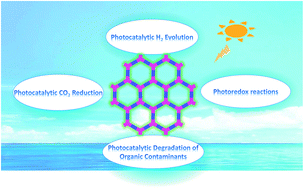
J. Mater. Chem. A, 2020,8, 6957-6983
https://doi.org/10.1039/D0TA00556H
Biomass-derived porous graphitic carbon materials for energy and environmental applications
This review presents the applications of biomass-derived porous graphitic carbon materials and their synthetic methods.

J. Mater. Chem. A, 2020,8, 5773-5811
https://doi.org/10.1039/C9TA11618D
Progress in nickel chalcogenide electrocatalyzed hydrogen evolution reaction
Nickel chalcogenides are a special class of electrocatalysts that possess exceptional HER activity and this review gives a comprehensive overview of their recent development.
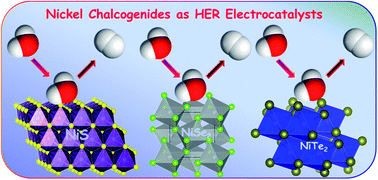
J. Mater. Chem. A, 2020,8, 4174-4192
https://doi.org/10.1039/C9TA14037A
Design and engineering of layered double hydroxide based catalysts for water depollution by advanced oxidation processes: a review
Various strategies to design LDH catalysts for advanced oxidation processes.
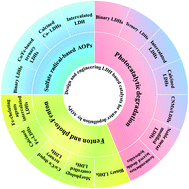
J. Mater. Chem. A, 2020,8, 4141-4173
https://doi.org/10.1039/C9TA13522G
Current progress in electrocatalytic carbon dioxide reduction to fuels on heterogeneous catalysts
As a promising and important carbon source, utilization of carbon dioxide (CO2) can effectively solve the energy crisis caused by fossil resource consumption and the environmental problems arising from the emission of CO2.
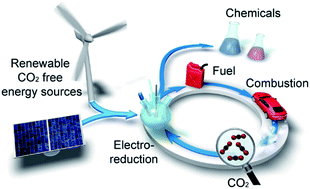
J. Mater. Chem. A, 2020,8, 3541-3562
https://doi.org/10.1039/C9TA11966C
Metal–organic frameworks and their derivatives with graphene composites: preparation and applications in electrocatalysis and photocatalysis
This review systematically summarizes the preparation strategies of metal–organic frameworks and their derivatives with graphene composites for promising applications in electrocatalysis and photocatalysis.

J. Mater. Chem. A, 2020,8, 2934-2961
https://doi.org/10.1039/C9TA12776C
Semiconductor-based photocatalysts for photocatalytic and photoelectrochemical water splitting: will we stop with photocorrosion?
This review outlines recent advances in strategies to improve the photoreaction stability of photocatalytic/photoelectrochemical water splitting systems, and discusses the tactics involved in improving the stability of such systems with different photocorrosion mechanisms.
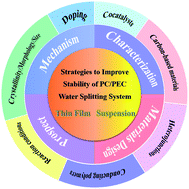
J. Mater. Chem. A, 2020,8, 2286-2322
https://doi.org/10.1039/C9TA12799B
Nucleation and crystal growth control for scalable solution-processed organic–inorganic hybrid perovskite solar cells
In this review, we provide an in-depth overview of perovskite film formation mechanism and highlight the important role of nucleation/crystal growth in perovskite photovoltaics by using scalable solution deposition techniques.

J. Mater. Chem. A, 2020,8, 1578-1603
https://doi.org/10.1039/C9TA11245F
A broadband aggregation-independent plasmonic absorber for highly efficient solar steam generation
A plasmonic solar absorber, featuring broadband light harvesting by manipulating the structural anisotropy at the single nanoparticle level, enables absorption over the entire solar spectrum.

J. Mater. Chem. A, 2020,8, 10742-10746
https://doi.org/10.1039/D0TA01980A
Mo-doped SnS2 with enriched S-vacancies for highly efficient electrocatalytic N2 reduction: the critical role of the Mo–Sn–Sn trimer
Mo-doped SnS2 nanosheets with enriched S-vacancies exhibited a greatly enhanced NRR activity, which is attributed to the creation of Mo–Sn–Sn trimer catalytic sites that can strongly activate N2 with a largely reduced energy barrier.

J. Mater. Chem. A, 2020,8, 7117-7124
https://doi.org/10.1039/D0TA01688H
Novel gas sensing platform based on a stretchable laser-induced graphene pattern with self-heating capabilities
Laser-induced graphene based gas sensor conformable to skin with low detection limit at low temperature.
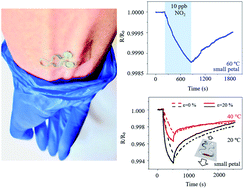
J. Mater. Chem. A, 2020,8, 6487-6500
https://doi.org/10.1039/C9TA07855J
Fe-doping induced morphological changes, oxygen vacancies and Ce3+–Ce3+ pairs in CeO2 for promoting electrocatalytic nitrogen fixation
Fe-doping induced synergetic effects, including the morphological change of crystalline CeO2 to partial-amorphous nanosheets, enriched O-vacancies and active Ce3+–Ce3+ pairs, were all responsible for the significantly enhanced NRR activity of Fe-CeO2.

J. Mater. Chem. A, 2020,8, 5865-5873
https://doi.org/10.1039/C9TA14260F
A chlorinated nonacyclic carbazole-based acceptor affords over 15% efficiency in organic solar cells
A systematic approach involving conjugation extension and end group chlorination is capable of enhancing both JSC and PCE. Overall, the PM6:DTTC-4Cl-based device delivers a remarkable PCE of 15.42% with a VOC of 0.92 V, a JSC of 22.64 mA cm−2 and an FF of 74.04%.

J. Mater. Chem. A, 2020,8, 1131-1137
https://doi.org/10.1039/C9TA12605H
Au nanoparticle-embedded, nitrogen-deficient hollow mesoporous carbon nitride spheres for nitrogen photofixation
Gold-embedded, nitrogen-deficient hollow mesoporous carbon nitride spheres are constructed to give a solar-to-ammonia conversion efficiency of 0.032% for nitrogen photofixation.
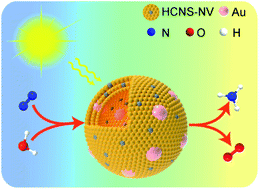
J. Mater. Chem. A, 2020,8, 16218-16231
https://doi.org/10.1039/D0TA03793A
Exclusive enhancement of catalytic activity in Bi0.5Na0.5TiO3 nanostructures: new insights into the design of efficient piezocatalysts and piezo-photocatalysts
Bi0.5Na0.5TiO3 nanospheres show superior piezo-photocatalytic activity in water splitting, Cr(VI) reduction and degradation of organic pollutants.

J. Mater. Chem. A, 2020,8, 16238-16245
https://doi.org/10.1039/C9TA14007G
Fe/Fe3C nanoparticle-decorated N-doped carbon nanofibers for improving the nitrogen selectivity of electrocatalytic nitrate reduction
N-doped carbon nanofibers embedded with Fe/Fe3C nanodomains demonstrate superior electrocatalytic nitrate reduction ability and nitrogen selectivity.

J. Mater. Chem. A, 2020,8, 15853-15863
https://doi.org/10.1039/D0TA02317E
Interfacial coordination assembly of tannic acid with metal ions on three-dimensional nickel hydroxide nanowalls for efficient water splitting
Interfacial coordination of tannic acid with metal ions enables conformal coating on nickel hydroxide nanowalls for enhancing the water-splitting performance.

J. Mater. Chem. A, 2020,8, 15845-15852
https://doi.org/10.1039/D0TA02229B
Mesoporous carbon confined intermetallic nanoparticles as highly durable electrocatalysts for the oxygen reduction reaction
An effective strategy was demonstrated to develop a highly durable catalyst prototype that combines superfine Pt-based intermetallic nanoparticles with mesoporous carbon.

J. Mater. Chem. A, 2020,8, 15822-15828
https://doi.org/10.1039/D0TA01437K
A MoO3/MoO2-CP self-supporting heterostructure for modification of lithium–sulfur batteries
A unique MoO3/MoO2 heterostructure with an active interface is an ideal host for Li2S8, exhibiting superior rate and long-term cycling performance.
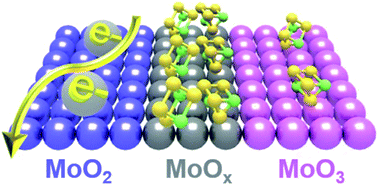
J. Mater. Chem. A, 2020,8, 15816-15821
https://doi.org/10.1039/D0TA01664K
Rational design of dual-metal-site catalysts for electroreduction of carbon dioxide
Dual-metal-site catalysts could exhibit superior activity for CO2 electroreduction to CO due to the breaking of scaling relationship.

J. Mater. Chem. A, 2020,8, 15809-15815
https://doi.org/10.1039/D0TA00033G
Aromatic porous polymer network membranes for organic solvent nanofiltration under extreme conditions
Organic solvent nanofiltration (OSN) membranes composed of aromatic porous polymer networks are fabricated by in situ cross-linking. They exhibit excellent chemical/structural stability, molecular-sieving selectivity, and high permeability for OSN.

J. Mater. Chem. A, 2020,8, 15891-15899
https://doi.org/10.1039/C9TA10190J
Identifying the electrocatalytic active sites of a Ru-based catalyst with high Faraday efficiency in CO2-saturated media for an aqueous Zn–CO2 system
For the aqueous Zn–CO2 system, strongly embedded Ru nanoparticles on the substrate reveal the improved hydrogen generation activities for indirect CO2 utilization.

J. Mater. Chem. A, 2020,8, 14927-14934
https://doi.org/10.1039/D0TA03050C
A smart porous wood-supported flower-like NiS/Ni conjunction with vitrimer co-effect as a multifunctional material with reshaping, shape-memory, and self-healing properties for applications in high-performance supercapacitors, catalysts, and sensors
Wood-based materials are attracting extensive attention for applications in energy storage due to their environmental friendliness and the presence of numerous channels in their structure.

J. Mater. Chem. A, 2020,8, 10898-10908
https://doi.org/10.1039/D0TA03664A
Super-stretchable, elastic and recoverable ionic conductive hydrogel for wireless wearable, stretchable sensor
A super-stretchable and self-recoverable ionic conductive hydrogel was designed and used as a wearable stretchable sensor to monitor human body motions.

J. Mater. Chem. A, 2020,8, 10291-10300
https://doi.org/10.1039/D0TA02902E
The HER/OER mechanistic study of an FeCoNi-based electrocatalyst for alkaline water splitting
In operando XAS investigation on FeCoNi-based thin film unravels that Fe3+-assisted water dissociation promotes the formation of Co2+–μ-H–Ni3+ species, and the conductive character of Co2+Ni3+-oxide matrix facilitates the coupling of adjacent [Fe4+![[double bond, length as m-dash]](https://www.rsc.org/images/entities/char_e001.gif) O/Fe3+–O˙] motifs.
O/Fe3+–O˙] motifs.
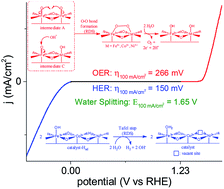
J. Mater. Chem. A, 2020,8, 9939-9950
https://doi.org/10.1039/D0TA01877E
A yolk–shell structured metal–organic framework with encapsulated iron-porphyrin and its derived bimetallic nitrogen-doped porous carbon for an efficient oxygen reduction reaction
A yolk–shell structured metal–organic framework (MOF) with encapsulated 5,10,15,20-tetraphenylporphyrinatoiron (FeTPP) in a zeolitic imidazolate framework (ZIF)-L-ZIF-8 is reported.

J. Mater. Chem. A, 2020,8, 9536-9544
https://doi.org/10.1039/D0TA00962H
Superhydrophilic porous carbon foam as a self-desalting monolithic solar steam generation device with high energy efficiency
Superhydrophilic porous carbon foam was successfully synthesized by facile carbonization of potato, providing a new perspective to design self-desalting monolithic ISSG to satisfy the demand for highly efficient and enduring solar desalination.
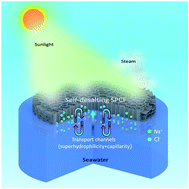
J. Mater. Chem. A, 2020,8, 9528-9535
https://doi.org/10.1039/D0TA01439G
Alkyl chain engineering of chlorinated acceptors for elevated solar conversion
A chlorinated acceptor with 2-butyloctyl side chains and a 3D interpenetrated structure in the single crystal shows excellent PCE up to 16.43%.
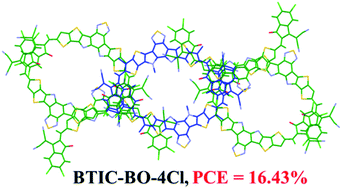
J. Mater. Chem. A, 2020,8, 8903-8912
https://doi.org/10.1039/C9TA12558B
Asymmetric gel polymer electrolyte with high lithium ion conductivity for dendrite-free lithium metal batteries
An asymmetric gel polymer electrolyte is designed for regulating ions and suppressing Li dendrite growth in high-performance Li metal batteries.
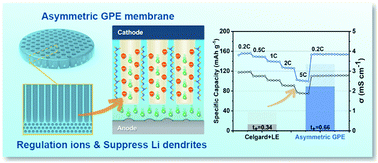
J. Mater. Chem. A, 2020,8, 8033-8040
https://doi.org/10.1039/D0TA01883J
In situ construction of hydrazone-linked COF-based core–shell hetero-frameworks for enhanced photocatalytic hydrogen evolution
Octahedral MOF@COF core–shell hetero-framework photocatalysts were designed which achieved superior photocatalytic H2-evolution activity.
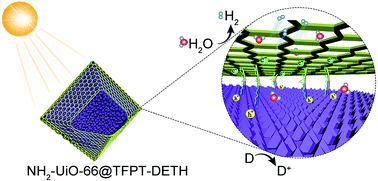
J. Mater. Chem. A, 2020,8, 7724-7732
https://doi.org/10.1039/D0TA00901F
An effective strategy of constructing a multi-junction structure by integrating a heterojunction and a homojunction to promote the charge separation and transfer efficiency of WO3
Constructing a multi-junction structure by integrating homojunction and heterojunction is an effective strategy for adequate light absorption, effective charge separation and transfer of WO3 photoanodes.

J. Mater. Chem. A, 2020,8, 6256-6267
https://doi.org/10.1039/D0TA00452A
Controlling the C2+ product selectivity of electrochemical CO2 reduction on an electrosprayed Cu catalyst
Copper catalyst with high C2 selectivity was synthesized by one-step electrospray pyrolysis. The C2/C1 ratio can be controlled easily by the spray amount of catalyst, and the C2 selectivity is very closely related to the structure of the catalyst.

J. Mater. Chem. A, 2020,8, 6210-6218
https://doi.org/10.1039/C9TA13173F
Ultrahigh discharge efficiency and improved energy density in rationally designed bilayer polyetherimide–BaTiO3/P(VDF-HFP) composites
Ultrahigh efficiencies over 95% and high energy densities are concurrently achieved in rationally designed bilayer polyetherimide–BaTiO3/P(VDF-HFP) composites.

J. Mater. Chem. A, 2020,8, 5750-5757
https://doi.org/10.1039/D0TA00903B
Synergistic boron-dopants and boron-induced oxygen vacancies in MnO2 nanosheets to promote electrocatalytic nitrogen reduction
The synergistic effect of B-dopants and B-dopant-induced O-vacancies led to the significantly enhanced NRR activity of MnO2 nanosheets with an NH3 yield of 54.2 μg h−1 mg−1 (−0.4 V) and a faradaic efficiency of 16.8% (−0.2 V).

J. Mater. Chem. A, 2020,8, 5200-5208
https://doi.org/10.1039/D0TA00220H
Ultra-thin trinity coating enabled by competitive reactions for unparalleled molecular separation
Inspired by the competition-driven evolution in nature such as for organismal complexity expansion, the covalent bond (CB)/coordination bond (COB) competitive reactions as the universal toolbox were conceived to construct the unparalleled molecular separation trinity coating.

J. Mater. Chem. A, 2020,8, 5078-5085
https://doi.org/10.1039/C9TA12670H
Polyelectrolyte complex-based self-healing, fatigue-resistant and anti-freezing hydrogels as highly sensitive ionic skins
Hydrogel-based self-healing ionic skins possess high mechanical strength, excellent resilience, anti-freezing properties and high sensitivity and can heal fatigue and mechanical damage to restore the original sensing performance.
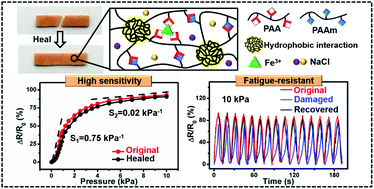
J. Mater. Chem. A, 2020,8, 3667-3675
https://doi.org/10.1039/C9TA13213A
A universal strategy to obtain highly redox-active porous carbons for efficient energy storage
A universal route based on benzoquinone and amines with different chemical structures and compositions is developed to engineer geometrically tailored, highly redox-active O/N codoped porous carbons for high-efficiency energy storage.

J. Mater. Chem. A, 2020,8, 3717-3725
https://doi.org/10.1039/C9TA13520K
A superhydrophobic fluorinated PDMS composite as a wearable strain sensor with excellent mechanical robustness and liquid impalement resistance
To endow strain sensors with superhydrophobicity may be a promising approach to improve the infrastructure safety in harsh environments.
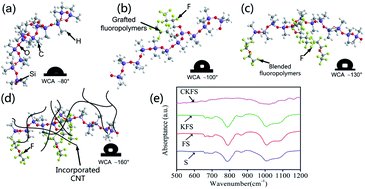
J. Mater. Chem. A, 2020,8, 3509-3516
https://doi.org/10.1039/C9TA13281C
Iron single-atom catalyst anchored on nitrogen-rich MOF-derived carbon nanocage to accelerate polysulfide redox conversion for lithium sulfur batteries
Permanent adsorption-conversion of lithium polysulfides by iron single atom anchored porous nitrogen-rich carbon nanocages endows lithium sulfur batteries with long lasting rate performance.
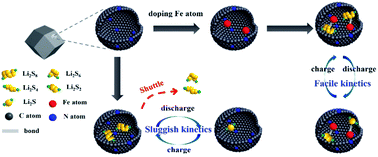
J. Mater. Chem. A, 2020,8, 3421-3430
https://doi.org/10.1039/C9TA11680J
An engineered self-supported electrocatalytic cathode and dendrite-free composite anode based on 3D double-carbon hosts for advanced Li–SeS2 batteries
A 3D double-carbon scaffold is delicately constructed as a universal host to engineer both SeS2 cathodes and dendrite-free Li metal anodes along with achieving reliable electrochemistry simultaneously for advanced Li–SeS2 batteries.

J. Mater. Chem. A, 2020,8, 2969-2983
https://doi.org/10.1039/C9TA11124G
Highly efficient tin perovskite solar cells achieved in a wide oxygen concentration range
Tin perovskite solar cells (TPSCs) as one of the most promising candidates for lead-free PSCs have large potential to be industrialized in the future.

J. Mater. Chem. A, 2020,8, 2760-2768
https://doi.org/10.1039/C9TA13159K
Necklace-like carbon nanofibers encapsulating V3S4 microspheres for ultrafast and stable potassium-ion storage
In this work, we have rationally designed a new necklace-like V3S4/carbon composite composed of V3S4 microspheres encapsulated into N-doped carbon nanofibers as advanced anode for potassium-ion batteries.

J. Mater. Chem. A, 2020,8, 2618-2626
https://doi.org/10.1039/C9TA12859J
Bimetallic metal–organic framework-derived MoFe-PC microspheres for electrocatalytic ammonia synthesis under ambient conditions
MoFe-PC exhibits a high yield rate and faradaic efficiency for NH3 electrosynthesis in acidic electrolytes due to the multicomponent active sites and inherent porous structure.

J. Mater. Chem. A, 2020,8, 2099-2104
https://doi.org/10.1039/C9TA10524G
Optimizing the rate capability of nickel cobalt phosphide nanowires on graphene oxide by the outer/inter-component synergistic effects
Bimetallic phosphides have been identified as promising alternative electrode materials owing to their admirable conductivity and electrochemical activity.

J. Mater. Chem. A, 2020,8, 1697-1708
https://doi.org/10.1039/C9TA12192G
Facile in situ solution synthesis of SnSe/rGO nanocomposites with enhanced thermoelectric performance
SnSe/rGO nanocomposites can be synthesised in situ via a facile solution method; once sintered, the lattice thermal conductivity and ZT of the composites are significantly reduced and enhanced respectively compared to SnSe itself.

J. Mater. Chem. A, 2020,8, 1394-1402
https://doi.org/10.1039/C9TA11737G
Oxidation-resistant titanium carbide MXene films
We have demonstrated a highly stable electric heater made of oxidation-resistant MXene film, which was capable of stable operation in air under highly oxidizing conditions (70 °C, 100% RH).

J. Mater. Chem. A, 2020,8, 573-581
https://doi.org/10.1039/C9TA07036B
About this collection
To mark the Lunar New Year, this web collection features the top 50 most popular articles published in Journal of Materials Chemistry A in 2020 by corresponding authors based in Asia.
Congratulations to all of the authors whose articles have been featured!